Part 1 of the Nemegt Fauna Series. Review and photos by Bokisaurus, edited by Suspsy.
Before we start, you may have noticed the title above. This review will be the first of a trilogy that I am planning to do. I have always wanted to do a review that not only discussed the specific prehistoric figure, but to also weave in some of the other fauna it lived with. My vision was to stitch these reviews so that they flow would from one to the next, creating a mini-series. Up until now, the opportunity never presented itself. While researching for this review, it occurred to me that this would finally be a good launching point for this experiment. So I hope that you all enjoy it.
The discovery in 1965 of a pair of enormous arms and shoulder blades was our first introduction to a mysterious dinosaur from the Late Cretaceous. This impressive animal was given the name Deinocheirus or “terrible hand.” The creature was discovered in the Gobi Desert of Mongolia in what is called the Nemegt Formation. For decades, these scant remains were the only material of this animal known to science. With such an incomplete record, its classification was uncertain. At first, it was thought that such formidable-looking arms must belong to a super predator, because what else would such impressive weaponry be used for other than to quickly kill prey animals?
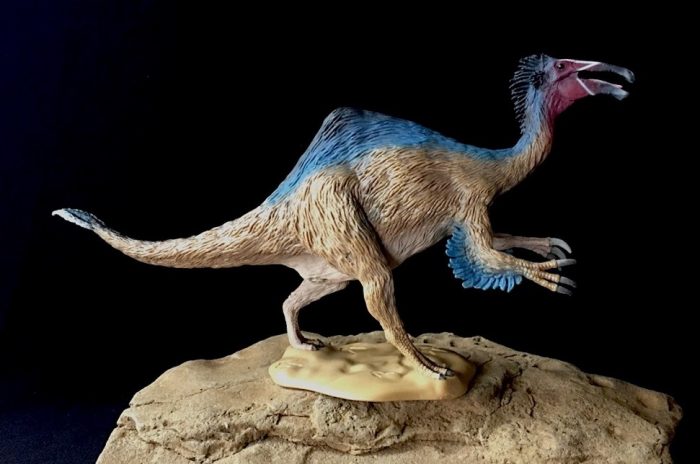
The mystery and debate about this animal’s true identity continued for almost fifty years. In 2006 and 2009, however, new fossil material from two individuals was discovered. Then in 2013, with this new evidence, the mystery of the true identity of Deinocheirus was finally solved with the formal announcement of these additional fossil finds. The result was a creature that is much weirder-looking than originally thought. If you combine the main body form of a theropod, add in the large arms and claws of Therizinosaurus (a contemporary), the hump of a camel, and finally, the head of a duckbill dinosaur, then you have Deinocheirus! With its true identity finally revealed, its status has gone from that of obscurity to one of the most well-known of all dinosaurs.
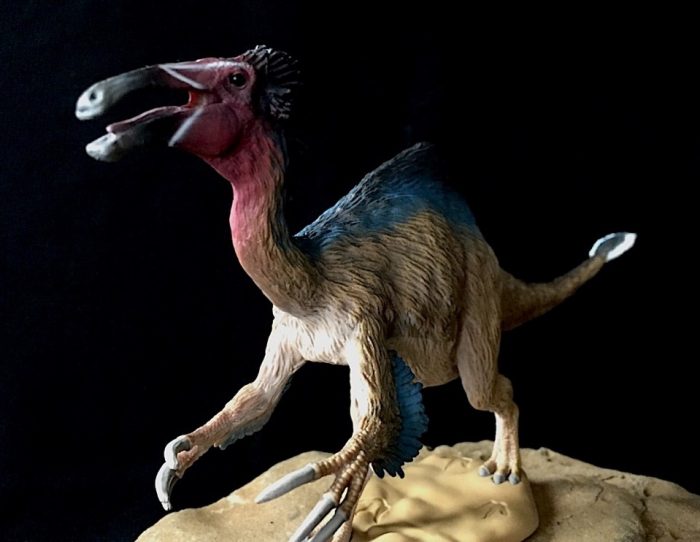
To date, CollectA has released three versions of Deinocheirus. They released their very first one way back in 2012, only a year before the formal announcement of new fossil material. Obviously, it was not accurate, but given the evidence back then, it’s a pretty good model for which you can read the review here. Then in 2016, CollectA released their second figure based on the latest findings. This version is well made and proved to be highly popular, so much so that CollectA decided to release yet another version this year! For their third figure, CollectA decided to scale it up and make it part of their Deluxe 1:40 Scale series. This new figure is the subject of our review today.
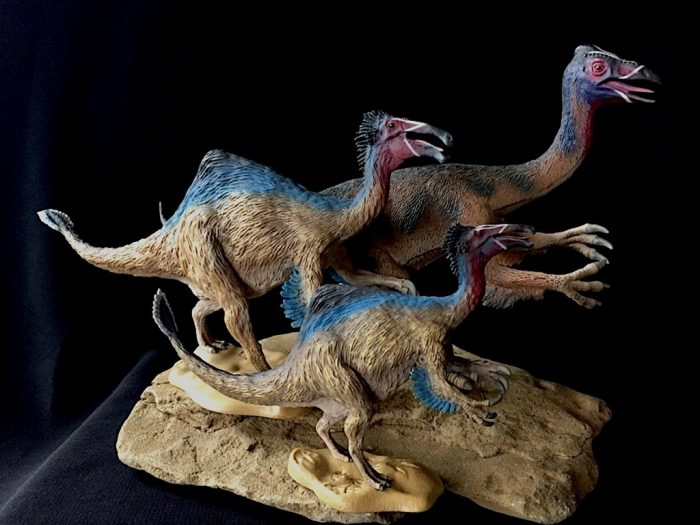
CollectA Deinocheirus throughout the years
It is worth noting that this larger version of Deinocheirus is almost exactly the same as the standard figure released last year except for its size. Besides that, the only other difference is the pose. In this new figure, both the body and tail, as well as the tail fan, are held up in a more horizontal orientation instead of the more vertical stance seen on the standard model. The angle of the head is also slightly tilted to one side on this new figure, and its arms are at the same height, whereas the standard figure’s right arm is held slightly lower than the left.
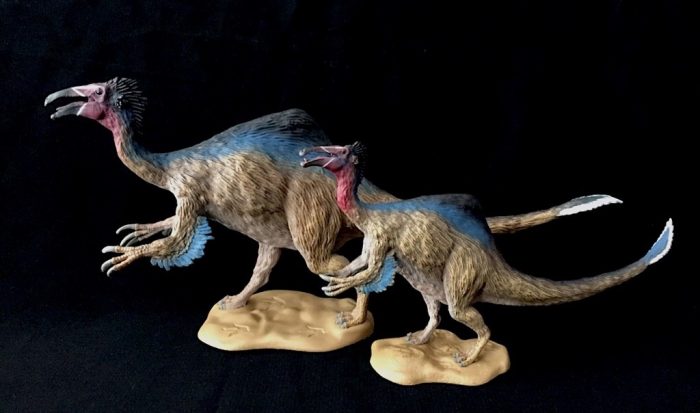
Deinocheirus was a huge animal, with some size estimates give at 11 meters long, almost as big as Tyrannosaurus rex itself. It is the largest known ornithomimosaur. Although most of these dinosaurs are lightly built and fast-running, Deinocheirus was not particularly built for speed. Its huge size may have been a factor. After all, if you are that big, your size alone could be your best weapon against predators and rivals alike. The figure is supposed to be at 1:40 scale, but may in fact be larger. It measures a good thirteen inches long stretched out, and stands five inches tall at the highest point, the hump. Just like the standard version, it is mounted on a base.
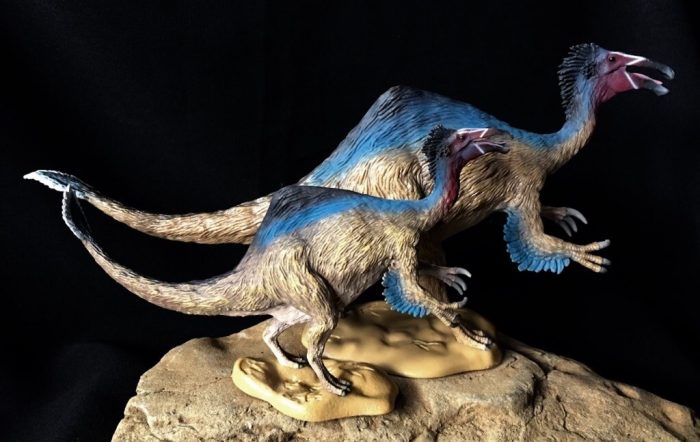
Now that we have covered the differences between the Standard and Deluxe figures, and since the former was already given a fabulous review here, there is not a whole lot left to say about this new figure that hasn’t already been covered in the Standard’s review. The two of them do make a wonderful pair. They could be male and female, or they could be an adult with its young, however you pair them is completely up to your imagination!
Back in the Late Cretaceous, what we know today as the Gobi Desert was once a lush woodland savanna, very much like today’s African Okavango region. The endless open grassland is broken by streams and rivers that meander along the plains. Shallow lakes also dot the landscape. At the edges of these lakes and rivers stands lush forest, thick with tall conifers that formed high canopies above. This rich habitat is where one would find Deinocheirus. Its height advantage allowed it to browse on tender greens higher up than most of the other residents here, with the exception of the titanosaurs. It is also believed that despite being primarily vegetarian, Deinocheirus was also an opportunistic omnivore. Fossil fish remains found among gastroliths associated with Deinocheirus support the theory that it pretty much ate anything from plants to small vertebrates. So the streams and shallow lakes also provided an extra source of food as well as water.
In this environment, what may look like first glance to be a flashy colour scheme at first glance actually has its advantage. The browns that dominate the body are broken by a band of blue running from the back of the neck until it reaches the hip area. Above the blue, a black band runs the length of the back, obscuring the hump. The various shades and splashes of red in the face, including the white lines, all serve a purpose. These colours and bands all help break up the animal’s silhouette in the dappled light of the forests it frequents. In short, the animal blends in with its surroundings.

Not far from the forest edge where Deinocheirus lives, a large shallow lake dominates the scene. Here a herd of Saurolophus, one of the few large hadrosaurs (duckbills) that shared the landscape, can be seen feeding and drinking at the shoreline. There are also ankylosaurs here, and one species, Saichania, can be seen mixed in with the Saurolophus herd leisurely feeding at the lake’s edge.

In the far distance, out in the open plain, a vast herd of Gallimimus, a smaller and much faster relative of Deinocheirus can be seen. Their tan bodies dot the plain like moving termite mounds. The large herd creates dust clouds as they hurriedly run from one feeding ground to another. Unlike Deinocheirus, they are build for speed, preferring the open grassland over the forest edge and spend most of their life wandering the plains. And somewhere mixed in with this herd are various species of oviraptorids.
Back at the forest edge, a large figure emerges from the darkness, startling a pair of Deinocheirus. With its large claws and feathers ruffled, a huge Therizinosaurus charges the pair. Slightly larger than Deinocheirus, it is clearly the more aggressive of the two species. They are not related, but clearly share the same features such as large arms and claws. This big male is the Deinocheirus’ grumpy neighbor. Not looking for a fight, the pair moves on, searching for a quieter place to have a meal.
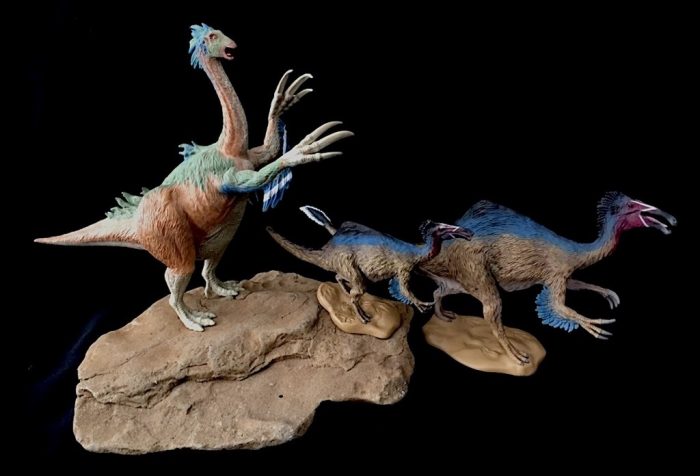
The peaceful coexistence of these animals is deceiving. Just like in today’s African plains, wherever there are abundant prey, there is surely a top predator somewhere. Sure enough, there are at least two or possibly three species of tyrannosaur staking this area. Not far from where the Deinocheirus, Saurolophus, and Therizinosaurus are feeding, a large shadowy figure appears. This is no ordinary or friendly figure. The wind carries his unmistakable scent and the animals by the lake know who it belongs to and are on high alert. This is Tarbosaurus, the top predator of the the land. With an estimated size between ten to twelve meters, he can easily take down any of these herbivores. The pair of Deinocheirus decide it’s best to retreat deeper in the forest where they will be safer.

Back out on the plain, another drama is unfolding. Exhausted by the heat and thirsty, the herd of Gallimimus is unaware of the danger that’s stalking them. Like a mirage, a figure appears and disappears in the distance, moving ever closer to the exhausted herd. But this is no mirage; this is Alioramus, the second, much smaller tyrannosaur that inhabits this place. It avoids direct conflict with its larger cousin by choosing a different prey and hunting style. It prefers the open plain where the vast herds of Gallimimus and oviraptorids provide abundant food source. Alioramus rarely ventures far from the open plains, so the Deinocheirus are not too concern about it. Still, the pair watches this unfolding drama with caution.

The thick forest provide the pair of Deinocheirus some level of protection. But with the panicked cries from the Saurolophus herd by the lake echoing through the forest, the Deinocheirus know its time to move on in search of a safer new home. With one final look, the pair turn around leaving the Saurolophus to their fate, and like a pair of shadows, vanish in the forest depth.
In closing, I find this Deluxe Deinocheirus figure from CollectA a must-have. Despite being almost identical to its Standard size predecessor, it still offers a lot of flexibility, and at this size, one can really appreciate the fine sculpting. It makes a nice pair to the smaller one, and it also pairs up nicely with some of the other 1:40 scale dinosaurs, making a fun diorama display. I hope you all enjoyed this review and the different format. On part 2 of the series, we will revisit the Nemegt Formation and meet up with Saurolophus. Till then, cheers!
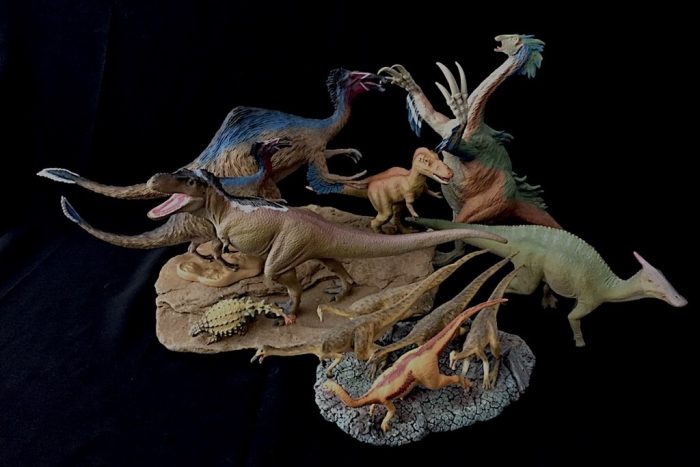
CollectA Deluxe 2017 and 2012 figures, as well as Standard 2016 figure
Kinto resin Gallimimus herd with Battat figure
Kaiyodo Saichania
CollectA Deluxe Therizinosaurus
CollectA Standard Alioramus
Favorite Tarbosaurus and Saurolophus museum exhibit special figures
Support the Dinosaur Toy Blog by making dino-purchases through these links to Ebay and Amazon. Disclaimer: links to Ebay.com and Amazon.com on the The Dinosaur Toy Blog are often affiliate links, when you make purchases through these links we may make a commission

An interesting aspect of Deinocheirus is that the shape of the ‘hump’ or ‘sail’ on the back is only known from the smallest specimen found. A sub-adult about 3/4 adult size.
Makes me wonder if the shape of the hump on the adults was the same, or was it just starting to emerge on the sub adult and in fact shaped more like a full rounded sail on the backs of the adults, rather than having a triangular peak to it as is portrayed in restorations.
[…] meets some of the forest’s more fascinating residents. Eyeing her with curiosity is a pair of Deinocheirus, those giant ornithomimosaurs with huge claws. They move closer and inspect this odd creature that […]
This piece looks gorgeous and the increased size is very enticing, I’ll look forward to adding it to my collection.
I wish the same amount of effort that went into sculpting it when into the base, it’s just such a massive gap in detail that it’s hard to ignore. Other than that, it’s a great replica, and a good review.
Beautiful photos, as always by Bokisaurus. I especially enjoyed the way the reviewer included so many dinosaurs from the same formation. I could almost hear David Attenborough narrating the tale in one of his documentaries like “Planet Earth”. Inspired work!
It is a beauty the new deinocheirus and it is wonderful and beautiful the description of the dinosaurs that inhabited Asia during the Cretaceous. Favorite saurolophus and tarbosaurus review is urgently needed soon.
By the way Collecta’s deinocherius Deluxe is much bigger than I imagined. I hope the company will start to release Deluxe versions of their dinosaurs and prehistoric animals, especially those from the Dark Ages of Collecta that do.
Nice toy, and nice review! Clever way of comparing the various models to the new kid. Part one a success!
Cool review, especially the vignette at the end! Kenneth Branagh probably would have enjoyed narrating it.